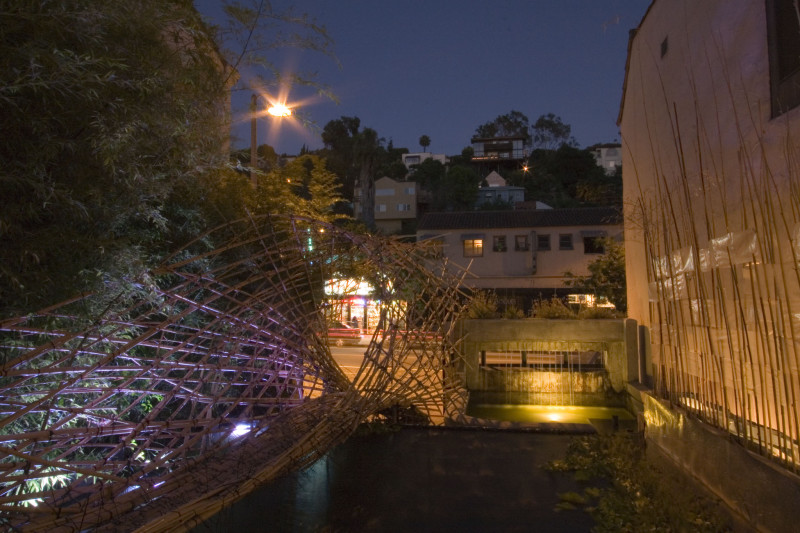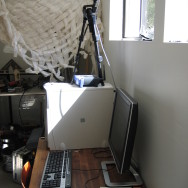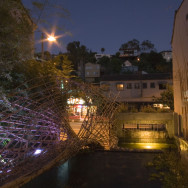On a bamboo bridge above a pond, human and monster meet through a gestural interface.
This installation explores the challenges of synchronizing the aesthetics and intrinsic characteristics of natural materials into a built environment, mediated with the latest computer aided design tools and embedded control system technologies. The installation is designed to challenge visitors with its subtle interactivity that references our universal fears and the more specific threats endemic today, including heightened surveillance of the private sector, increased computational control of daily life, and the poisoning of our environment.
The entire system runs on 4 computers with the artificial life of all “monsters” being created within the systhesis of information from all sensory modalities. The basis of human machine interaction is infrared firewire cameras used primarily for assembly line part inspection. The input is filtered through a number of programs that all approach vision differently, becoming a testbed for various infranatural projects. The vision data is then shared and exploited by simple finite state machines which then queue reactions and anticipation within a larger boid simulation (an artificial life program, modeled on the flocking behaviour of birds) of a large aqueous volume. The simulation keeps track of the surface condition of the water based on the wakes of various “monster” interactions via the use of midi and 48 variable frequency pumps.
Three types of “monsters” inhabit the water garden. Their artificial intelligence derives stimulation from visitors’ fear of the unknown, of being alone, and of themselves. A surveillance network watches and analyses their motions, actions, and reactions around the water. infranatural has designed all the systems to be self-learning and modifying so the installation will grow within its simulated environment while the bamboo woven into the bridge dries and hardens and tropical aquatic plants begin to flourish in the chemical-free rain-catchment water. The entire environment evolves over the course of the exhibition -visitors are invited to come back regularly to see what has thrived and what has shriveled. A “chaordic” system has been created here that simultaneously strives towards chaos and order – a principle that is as basic as survival of the fittest and one that is inherent in the hybrid vigour of this ecosystem whose components’ adaptation is dependent not just on the basic resources of rain and sun but also upon the attention and interest of the visitor.
Materials & Applications, Silver Lake, California, 2006
Concept Design Jenna Didier and Oliver Hess
Water engineering Jenna Didier
Software and hardware design Oliver Hess
Bridge engineering and architecture Bruce Danziger of Arup and Workshop Levitas
This installation was built by the volunteers at Materials & Applications



